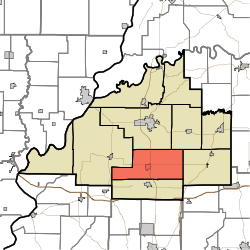Union Township, Gibson County, Indiana
Union Township is one of ten townships in Gibson County, Indiana. As of the 2010 census, its population was 4,197 and it contained 1,779 housing units, 90% of which live in areas adjacent to Fort Branch.[3] Fort Branch is the township seat. Nearly all of the Toyota Motor Manufacturing Indiana Complex is located within Union Township.
Union Township Gibson County | |
|---|---|
 Location of Union Township within Gibson County | |
| Coordinates: 38°14′47″N 87°33′19″W | |
| Country | United States |
| State | Indiana |
| County | Gibson |
| Township Seat | Fort Branch |
| School District | South Gibson School Corporation |
| Named for | The Union |
| Government | |
| • Type | Indiana township |
| • Trustee | Brenda Sollman |
| Area | |
| • Total | 50.43 sq mi (130.6 km2) |
| • Land | 50.31 sq mi (130.3 km2) |
| • Water | 0.12 sq mi (0.3 km2) |
| Elevation | 456 ft (139 m) |
| Population (2014) | |
| • Total | 4,245 |
| • Density | 84.17/sq mi (32.50/km2) |
| Time zone | UTC-6 (CST) |
| • Summer (DST) | UTC-5 (CDT) |
| ZIP code | 47648 |
| Area code(s) | 812 |
| FIPS code | 18-77300[2] |
| GNIS feature ID | 453916 |
Union Township was established in 1890.[4]
Geography
According to the 2010 census, the township has a total area of 50.43 square miles (130.6 km2), of which 50.31 square miles (130.3 km2) (or 99.76%) is land and 0.12 square miles (0.31 km2) (or 0.24%) is water.[3]
Cities and towns
Unincorporated towns
- Durham (extinct)
- Fort Gibson (extinct)
- Snake Run
Adjacent townships
- Patoka Township (north)
- Center Township (northeast)
- Barton Township (east)
- Johnson Township (south)
- Montgomery Township (west)
Cemeteries
The township contains three cemeteries: Durham, Mount Mariah and Walnut Hill.
Major highways



Education
Union Township is the center of the South Gibson School Corporation.
Public schools
- Fort Branch Community School
- Gibson Southern High School
Higher Education
- Vincennes University Advanced Manufacturing Campus
Private schools
- Holy Cross Catholic Academy - Fort Branch
gollark: What?
gollark: What if we rewrite the helloboi algorithm in Rust?
gollark: Any insults would be appropriately dealt with.
gollark: Yes.
gollark: Which is noninsulting.
References
- "US Board on Geographic Names". United States Geological Survey. 2007-10-25. Retrieved 2008-01-31.
- "U.S. Census website". United States Census Bureau. Retrieved 2008-01-31.
- "Population, Housing Units, Area, and Density: 2010 - County -- County Subdivision and Place -- 2010 Census Summary File 1". United States Census. Archived from the original on 2020-02-10. Retrieved 2013-05-10.
- Stormont, Gil R. (1914). History of Gibson County, Indiana: Her People, Industries and Institutions. B.F. Bowen. pp. 353.
This article is issued from Wikipedia. The text is licensed under Creative Commons - Attribution - Sharealike. Additional terms may apply for the media files.
